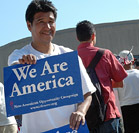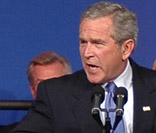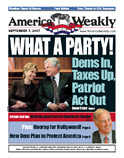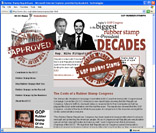


Credits: Democracy in Action; CIA World Fact Book; Democracy in Action.
Governors
| U.S. Senate
| U.S.
House | More
| Photos | Results



Credits: Democracy in Action;
CIA World Fact Book; Democracy in Action.
Mid-term elections often
result in losses for the party holding the White House, but the power of
incumbency and non-competitive districts weigh against major changes
[Eric M. Appleman - revised
Nov. 5, 2006] Throughout much of 2006 the conventional wisdom has been
that Democrats stand a good chance of regaining narrow control of the House,
where they need to pick up 15 seats, but that they face long odds in the
Senate where they need six seats. There are many other important
contests on the ballot on November 7. Thirty six governorships, control
of state legislatures, and various initiatives and referenda are at stake,
but the battle for the House has drawn the most attention.
The political environment strongly favored the Democrats in their quest to regain control of the House after 12 years in the minority. First, 2006 was the sixth-year of the Bush presidency, and the party in power has traditionally lost seats in sixth-year congressional elections. Second, a number of issues weighed against Republicans, top among them the situation in Iraq. Other issues included President Bush's stalled effort to overhaul Social Security, high gas prices, Bush's handling of Hurricane Katrina, and what Democrats called "a culture of corruption." These all compounded upon each other and Bush's job approval ratings remained consistently low throughout the year. The Republican controlled Congress did not fare well either; a June 6, 2006 Cook Political Report/RT Strategies Poll found 61 percent disapproved of the job Congress is doing. A coup de grace hit on September 29, 2006 when the scandal over Rep. Mark Foley (R-FL) and his salacious messages to House pages broke.
Weighing against major changes in the lower chamber are the power of incumbency and the increasing number of non-competitive districts.1 However as Election Day 2006 approached the field of competitive seats expanded rather than shrank. For the Democrats, thirty-three open House seats offered some initial possibilities. (Sixteen of these were opened up by members seeking higher office, plus one by a member appointed to higher office. There were 12 outright retirements, three resignations due to scandal and two members defeated in the primaries). With forty to fifty seats in play the Democrats appeared all but certain to take back the House:
IRAQ: "CUT AND RUN"
VS. "STAY THE COURSE"
No issue loomed larger in
the mid-terms than Iraq. The fact that Iraq appeared to be on the
verge of civil war created major difficulties for President Bush and Republicans
in Congress. Day after day reports of suicide bombings and sectarian
violence filled the news, and casualties among the troops continued to
rise. A September 22, 2006 Congressional Research service report
put spending on Operation Iraqi Freedom at $8 billion per month and the
cumulative total through FY 2006 at $318.5 billion.5
Beyond these statistics there were the more than 2,700 U.S. military fatalities.6
There were occasional glimmers of progress in Iraq, such as the elections
on January 30, 2005 and December 15, 2005 or the news of a June 8, 2006
air strike that killed the terrorist Abu Musab al-Zarqawi, but October
2006 was a particularly bloody month. President Bush steadfastly
maintained that "our safety depends on the outcome of the battle in Iraq."
"Withdrawing from Iraq before the enemy is defeated would embolden the
terrorists," he declared in his October 1, 2006 radio address.
Democrats argued that "stay the course" was not a strategy and some referred to the conflict as "a war of choice." These arguments seemed to be having an effect, for in the latter part of October the Administration made a determined effort to counteract the "stay the course" tag. For example in an October 23 briefing Press Secretary Tony Snow described the policy as "a study in constant motion by the administration and by the Iraqi government, and, frankly, also by the enemy..." However there were conflicting signals; in an November 1 interview in the Oval Office, Bush told the Associated Press that he planned to keep Vice President Dick Cheney and Defense Secretary Donald Rumsfeld in place. "Both those men are doing fantastic jobs and I strongly support them," Bush stated. Looming on the horizon is the report of the Iraq Study Group, co-chaired by former Secretary of State James Baker and former congressman Lee Hamilton; this is due to come out after the election and is seen as likely to serve as the basis for a reexamination of Iraq policy.
A significant concern for Democrats was their vulnerability to being labeled weak on terrorism. In a speech at a fundraiser for Gov. Bob Riley (R-AL), Bush declared, "Five years after 9/11, the worst attack on American homeland in our history, the Democrats offer nothing but criticism and obstruction, and endless second-guessing." "The party of FDR and the party of Harry Truman has become the party of cut-and-run," Bush said. In the latter part of October the RNC's limited airing of an ad "The Stakes," featuring Osama bin Laden, generated tremendous media attention. Republicans made hay of Sen. John Kerry's (D-MA) fumbled joke in a October 30 speech, saying it showed disrespect for the military. Kerry had stated, “You know, education, if you make the most of it, you study hard, you do your homework and you make an effort to be smart, you can do well. If you don’t, you get stuck in Iraq.” Kerry insisted his remarks were aimed at President Bush, but apologized and pulled himself off the campaign trail.
One way in which Democrats insulated themselves from these charges was by running a dozens of veterans as candidates for Congress around the country. (See: Band of Brothers, which held an event on the National Mall on February 8, 2006; Iraq and Afghanistan Veterans of America PAC (IAVA PAC); VETPAC; and the DNC's "Fighting Dems" page).
"CULTURE OF CORRUPTION"
Democrats have found much
to criticize with the Bush Administration and the "Rubber Stamp Republican
Congress." In Fall 2005 they focused particular attention on what
they called the "culture of corruption." Top lobbyist Jack Abramoff
was indicted on August 11, 2005 by a federal grand jury in Fort Lauderdale,
FL on fraud and conspiracy charges. A Texas grand jury indicted
House Majority Leader Tom DeLay (R-TX) on September 28, 2005 for conspiracy
to violate campaign finance laws, forcing him to step down from his leadership
position and eventually resign. Senate Majority Leader Bill Frist
(R-TN) came under investigation for the sale of HCA stock held in a blind
trust. Washington was fixated for weeks on whether special prosecutor
Patrick Fitzgerald's investigation into the outing of CIA agent Valerie
Plame would lead to indictment of President Bush's top aide Karl Rove.
Finally, on October 28, 2005, Fitzgerald announced indictment of Vice President
Cheney's Chief of Staff I. Lewis "Scooter" Libby on five charges.
Republicans generally discounted these as partisan attacks and "chatter."
Then came the blatant case of Rep. Randy "Duke" Cunningham (R-CA); he pleaded
guilty to fraud, conspiracy to commit bribery and tax evasion and resigned
effective December 1, 2005. Rep. Bob Ney (R-OH) was implicated in
corruption investigations, but maintained for many months that he had done
nothing wrong. He won the May 2, 2006 primary but on August 7 announced
he would not seek re-election, prompting a September 14 special primary
election won by state Sen. Joy Padgett. On September 15 Ney agreed
to plead guilty, on October 13 he did plead guilty to conspiracy and making
false statements and on November 3 he finally resigned from Congress.
More of these problems seemed to be in the news as Election Day approached. On September 28, 2006 the House Committee on Government Reform reported that "between January 2001 and March 2004, there were 485 lobbying contacts between Mr. Abramoff and his associates and White House officials." This prompted Susan B. Ralston, an aide to Karl Rove, to resign on October 6. Ney pleaded guilty to conspiracy and making false statements on October 13, but he has not resigned. Also in mid-October word emerged that Rep. Curt Weldon (R-PA), engaged in a tight race for re-election, was being investigated by the FBI on the propriety of contracts obtained by his daughter, and the Phoenix New Times raised questions about a land deal involving Rep. Rick Renzi (R-AZ).
Democrats had their own problems. In April 2006 Rep. Alan Mollohan (D-WV) stepped down from his position on the Ethics Committee due to an investigation into his financial dealings. In May 2006 a soap opera story about Rep. William Jefferson (D-LA) unfolded, when it was revealed that in August 2005 the FBI had videotaped the congressman accepting $100,000 from an investor. Soon thereafter agents found $90,000 of that money in Jefferson's freezer. In October 2006 news broke that Senate Democratic Leader Harry Reid (D-NV) had not properly disclosed a lucrative land deal; Reid had earlier been criticized for attending boxing matches without paying for the tickets.
IMMIGRATION
Immigration
was a major issue in the first part of 2006 although the intensity had
diminished somewhat as Election Day drew near. Democrats had a field
day criticizing the tough bill the House passed on immigration (HR 4437,
the Sensenbrenner bill) and enjoying the divisions among Republicans on
this issue. President Bush's advocacy of a path to citizenship and
a guest worker program caused considerable discomfort in his party.
Particularly difficult was the question of how to deal with the 12 million
illegal immigrants living in the United States. In Spring 2006 immigration
reform advocates had some hopes of achieving success. However the
huge rallies around the country on April 10, 2006 may have marked the high
watermark. On June 6 in the election to replace Rep. Cunningham in
California, former Rep. Brian Bilbray (R) successfully fended off Francine
Busby (D) in part by emphasizing his support for strong measures to control
illegal immigration. On September 29, on its last day in session
before the mid-term elections, the Senate voted 80 to 19 to authorize construction
of 700 miles of fencing along the Mexican border (Secure Fence Act of 2006,
H.R. 6061).
The House had earlier approved the measure.
REPUBLICANS
Conventional wisdom throughout
2006 has been that the numbers of Republican House members will be reduced
following the mid-term election. Republican prospects, which slumped
in the summer, seemed to be on the upswing in September as gas prices declined
and President Bush gave a series of strong speeches on Iraq. NRCC
chairman Rep. Tom Reynolds (R-NY), expressed confidence that Republicans
would still be in the majority in the 110th Congress. He saw "about
three dozen hotly contested races." Discounting national trends Reynolds
stated, "All politics is local." "We are working it with the three
M's [money, message and members]," he said.
However on September 29, little more than five weeks before the election, Rep. Mark Foley (R-FL) resigned in scandal involving explicit messages to House pages. Questions were raised about whether House Republican leaders had covered up or at least failed to take seriously warning signs. The Washington Times' lead editorial on October 3 opined "Resign, Mr. Speaker." NRCC chairman Reynolds found himself on the defensive in his campaign against businessman Jack Davis, to the extent that he ran a TV ad focusing specifically on the Foley scandal. "Nobody's angrier and more disappointed that I didn't catch his lies," Reynolds said in the ad. Even with the Foley scandal in the mix, during a radio day publicity blitz held just two weeks before November 7, White House strategist Karl Rove was blithely predicting Republicans would maintain their majorities in both the Senate and the House.
Republicans can point to accomplishments such as the tax cuts they have implemented and a number of strong economic indicators. A June 5, 2006 memo from Dan Bartlett, counselor to the President, stated, "From uniting the world community in preventing Iran from making a nuclear weapon to successfully installing qualified officials at home, and from assisting the Iraqi people in setting up a unity government to overseeing a strong economy that continues to create jobs for American workers, President Bush's leadership is achieving a steady flow of results that do not always dominate the day's headlines on their own but that together represent real progress for the American people." The Bush Administration tried without much success to highlight the strength of the economy. For example at an October 11, 2006 event highlighting reduction of the budget deficit to $248 billion, Bush noted that the economy was in its 37th straight month of growth, 6.6 million new jobs had been created since August 2003, and the national unemployment rate was down to 4.6 percent.
Republicans have presented themselves as best equipped to prosecute the war on terror, have castigated "angry" Democrats, and have painted an alarming view of what would happen if House Democratic Leader Nancy Pelosi, hailing from liberal San Francisco, were to become Speaker. If Democrats gain control of the House there will clearly be a very different dynamic than if Republicans retain the majority. Democrats have promised greater accountability and oversight. The RNC meanwhile presented its view of what life might look like should the Democrats succeed in a September 7, 2006 online newspaper America Weakly. The cover included a photo of Senators Hillary Rodham Clinton (D-NY) and Edward Kennedy (D-MA) and the headline "Dems In, Taxes Up, Patriot Act Out." Another headline read, "History! Impeachment Hearings Begin."7
DEMOCRATS
Democrats' ability to present
a compelling, positive agenda of their own remains to be proven.
Certainly they are for change and they are expert at lambasting the "Rubber
Stamp Republican Congress" or the "Do Nothing Congress" or the culture
of corruption or President Bush's handling of everything from tax cuts
to Iraq to Katrina.8
Many Democratic candidates are attempting to tie their Republican opponents
to Bush. William Galston and Elaine Kamarck's study The Politics
of Polarization,9
released
by Third Way on October 6, 2005, offered one set of ideas and was widely
discussed. In an October 14, 2005 letter to the editor to the New
York Times, former CBS News anchor Walter Cronkite raised the idea
of a Democratic mid-term convention. There were suggestions that
Democrats might try to emulate the Republicans' "Contract with America"
from 1994. For a while it looked as if the Democrats might try to
coast on corruption or immigration or dissatisfaction with the war in Iraq.
Finally on June 16, 2006 Democratic congressional leaders rolled out their
"New Direction for America." The agenda has six main points: make
health care more affordable, lower gas prices and achieve energy independence,
help working families, cut college costs, ensure dignified retirement,
and require fiscal responsibility. The second half of the agenda
makes the case that, "The Bush Administration and the Republican Majority
in Congress have taken the country in the wrong direction for Americans
and their families."10
House Democrats also presented a set of six objectives for their first
hundred hours, should they win the majority.
A cornerstone of the Democrats' efforts to take back the House is the DCCC's Red to Blue program "designed to provide financial and structural aid to the strongest Democratic candidates across the country." Thus far the DCCC has announced 41 Red to Blue candidates in three waves (the first 21 candidates, the second 13 candidates and the third eight candidates). Additionally the DCCC has announced 15 "emerging races" featuring candidates "who have taken traditionally non-competitive districts and, through the strength of their campaigns, put themselves in a position to win in November." Congressman Chris Van Hollen (D-MD) and Congresswoman Debbie Wasserman Schultz (D-FL) co-chair the Red to Blue program. The Democrats' efforts could be hampered by friction between DCCC chairman Rep. Rahm Emanuel (D-IL) and DNC chairman Howard Dean.
SETTING THE STAGE FOR
'08
Six years after the 2000
presidential election concluded in the Florida debacle, many Americans
still have questions about the integrity of voting systems. Doug
Chapin, director of electionline.org, stated that, “The ingredients are
there for problems in some parts of the country.” A press release
accompanying electionline.org's October 24, 2006 report stated that, "An
estimated third of all voters will cast ballots on voting systems never
before used in a general election, while new procedures and legal battles
over voter identification could confuse voters, poll workers or both."
Further, "Unfinished and just-completed statewide voter registration databases,
required as of Jan. 1, 2006 by the Help America Vote Act, have led to some
confusion in parts of the country as state agencies combine records and
local election officials cede control of their long-held registration rosters,"
the release said.11
One other interesting question to consider for 2006 is that of whether women be able to increase their representation. Heading into the 2006 elections they held eight of 50 governorships (16 percent - 6D and 2R), 14 of 100 U.S. Senate seats (14 percent - 9D and 5R) and 67 of 435 U.S. House seats (15.4 percent - 43D and 24R; also three delegates from DC, GU, and USVI). (more)
The 2006 mid-term elections
will set the stage for the 2008 presidential election. Potential
presidential candidates are doing their best to help elect candidates of
their party in races around the country. Control of Congress will
shape the agenda for the next two years and help set the terms of the debate
among the presidential candidates.
ema
updated 11/04/2006
Notes:
1. FairVote. "Dubious
Democracy 2005." July 25, 2005.
2. Mark Gersh. "Changing Demographics and Hope for 2006." NCEC Memo. Sept. 15, 2005.
3. Campaign Finance Institute. "Democratic Challengers Financially Stronger than Two Years Ago in Potentially Competitive House Districts." Oct. 27, 2005. and "Million Dollar House Challengers Have Nearly Doubled." Oct. 19, 2005.
4. American Political Science Association. "Political Scientists' Models Predict Democratic Takeover of House of Representatives." Oct. 17, 2006. (press release)
5. Amy Belasco. "The Cost of Iraq, Afghanistan, and Other Global War on Terror Operations Since 9/11." CRS Report. Updated Sept. 22, 2006.
6. Iraq
Casuality Coalition Count website, run by Michael White.
| 7. |  |
 |
| RNC Sept. 7, 2006 | RNC ad "The
Stakes"
limited run on cable Oct. 22, 2006 |
| 8. |  |
 |
| "The Corruption
Files"
DNC web page Oct. 2005 |
www.dccc.org/rubberstampcongress
DCCC web page Sept. 29, 2006 |
9. William Galston and Elain Kamarck. "The Politics of Polarization." Third Way. Oct. 6, 2005.
10. "A New Direction for America." June 16, 2006. Also revised edition, July 27, 2006.
11. electionline.org.
“Election
Preview 2006: What’s Changed, What Hasn’t and Why.” Oct. 24,
2006.
previous edition: 11
months out
| Copyright © 2005, 2006 Eric M. Appleman/Democracy in Action |  |